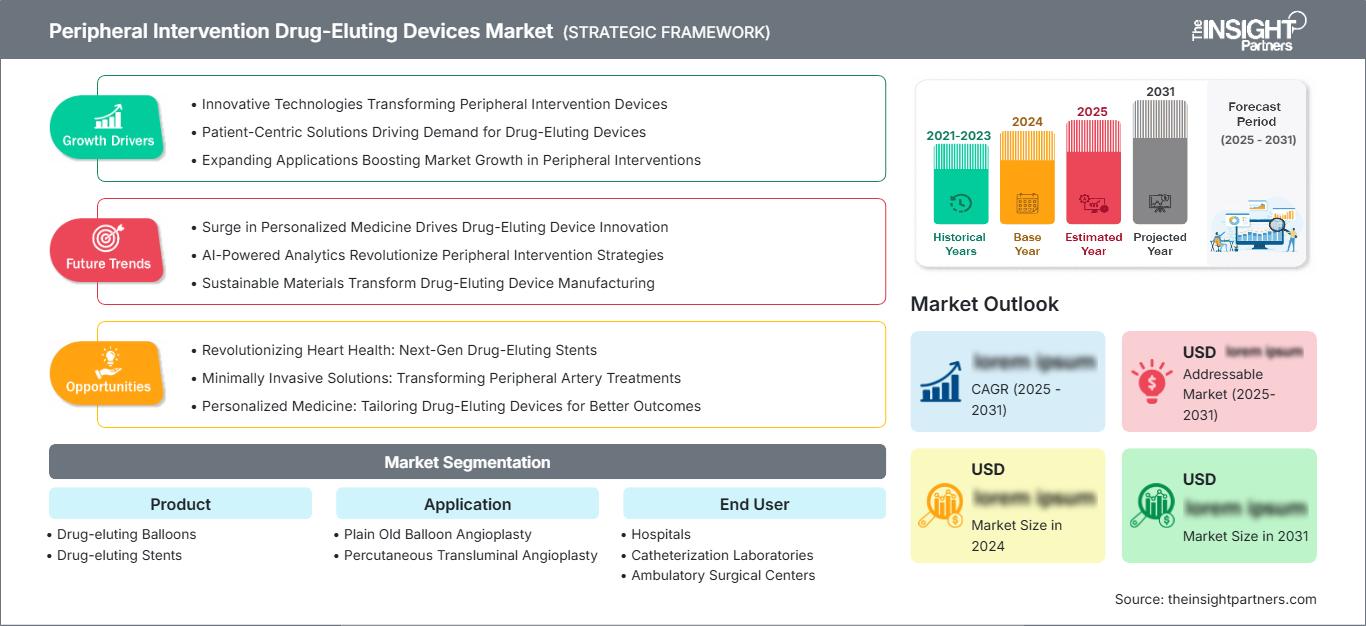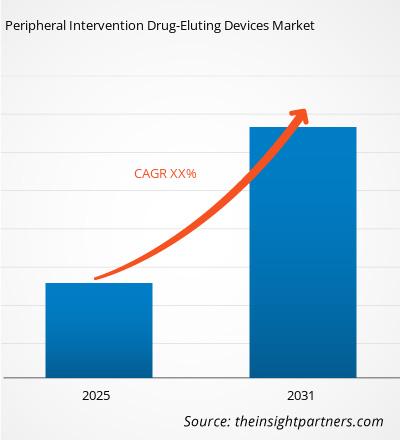Der Markt für medikamentenfreisetzende Systeme zur peripheren Intervention wird voraussichtlich von 2026 bis 2034 ein kontinuierliches Wachstum verzeichnen. Die Marktkapitalisierung soll gegenüber dem Basisjahr 2025 steigen und bis zum Ende des Prognosezeitraums ein nachhaltiges Wachstum aufweisen. Dieser Trend spiegelt positive Marktaussichten wider, die durch sich wandelnde Branchenanforderungen und fortschreitende technologische Entwicklungen begünstigt werden.
Der Bericht ist nach Produkt (medikamentenbeschichtete Ballons, medikamentenbeschichtete Stents) kategorisiert und analysiert den Markt weiterhin nach Anwendung (klassische Ballonangioplastie, perkutane transluminale Angioplastie). Er untersucht den Markt auch nach Endnutzer (Krankenhäuser, Herzkatheterlabore, ambulante Operationszentren). Für jedes dieser Schlüsselsegmente wird eine umfassende Aufschlüsselung auf globaler, regionaler und Länderebene bereitgestellt.
Der Bericht enthält Marktgrößen und Prognosen für alle Segmente, dargestellt in US-Dollar. Er liefert außerdem wichtige Statistiken zum aktuellen Marktstatus führender Akteure sowie Einblicke in vorherrschende Markttrends und neue Chancen.
Zweck des Berichts
Der Bericht „Markt für medikamentenfreisetzende Peripheriegeräte“ von The Insight Partners beschreibt die aktuelle Marktlage und das zukünftige Wachstum, die wichtigsten Triebkräfte, Herausforderungen und Chancen. Er bietet Einblicke für verschiedene Marktteilnehmer, darunter:
- Technologieanbieter/Hersteller: Um die sich entwickelnde Marktdynamik zu verstehen und die potenziellen Wachstumschancen zu erkennen, damit sie fundierte strategische Entscheidungen treffen können.
- Investoren: Um eine umfassende Trendanalyse hinsichtlich der Marktwachstumsrate, der finanziellen Marktprognosen und der Chancen entlang der gesamten Wertschöpfungskette durchzuführen.
- Regulierungsbehörden: Zur Regulierung von Richtlinien und Überwachungstätigkeiten auf dem Markt mit dem Ziel, Missbrauch zu minimieren, das Vertrauen der Anleger zu erhalten und die Integrität und Stabilität des Marktes zu wahren.
Marktsegmentierung für medikamentenfreisetzende Geräte zur peripheren Intervention – Produkt
- Medikamentenfreisetzende Ballons
- Medikamentenfreisetzende Stents
Anwendung
- Ganz normale Ballonangioplastie
- Perkutane transluminale Angioplastie
Endbenutzer
- Krankenhäuser
- Herzkatheterlabore
- Ambulante Operationszentren
Sie erhalten eine kostenlose Anpassung aller Berichte – einschließlich Teilen dieses Berichts, Länderanalysen und Excel-Datenpaketen – sowie attraktive Angebote und Rabatte für Start-ups und Universitäten.
Markt für medikamentenfreisetzende Peripheriegeräte: Strategische Einblicke

-
Ermitteln Sie die wichtigsten Markttrends dieses Berichts.Diese KOSTENLOSE Probe beinhaltet eine Datenanalyse, die von Markttrends bis hin zu Schätzungen und Prognosen reicht.
Wachstumstreiber des Marktes für periphere interventionelle medikamentenfreisetzende Geräte
- Innovative Technologien revolutionieren periphere Interventionsgeräte
- Patientenorientierte Lösungen treiben die Nachfrage nach medikamentenfreisetzenden Medizinprodukten an
- Erweiterte Anwendungsgebiete kurbeln das Marktwachstum bei peripheren Interventionen an
Markt für medikamentenfreisetzende Peripheriegeräte: Zukunftstrends
- Der Boom in der personalisierten Medizin treibt die Innovation von medikamentenfreisetzenden Implantaten voran.
- KI-gestützte Analysen revolutionieren periphere Interventionsstrategien
- Nachhaltige Materialien revolutionieren die Herstellung von arzneimittelfreisetzenden Medizinprodukten
Marktchancen für medikamentenfreisetzende Geräte zur peripheren Intervention
- Revolutionierung der Herzgesundheit: Medikamentenfreisetzende Stents der nächsten Generation
- Minimalinvasive Lösungen: Revolutionäre Behandlungsmethoden für periphere Arterien
- Personalisierte Medizin: Maßgeschneiderte Medikamentenfreisetzungssysteme für bessere Behandlungsergebnisse
Markt für periphere, medikamentenfreisetzende Medizinprodukte – Regionale Einblicke
Die regionalen Trends und Einflussfaktoren auf den Markt für medikamentenfreisetzende Systeme zur peripheren Intervention im gesamten Prognosezeitraum wurden von den Analysten von The Insight Partners eingehend erläutert. Dieser Abschnitt behandelt außerdem die Marktsegmente und die geografische Verteilung des Marktes für medikamentenfreisetzende Systeme zur peripheren Intervention in Nordamerika, Europa, dem asiatisch-pazifischen Raum, dem Nahen Osten und Afrika sowie Süd- und Mittelamerika.
Marktbericht über medikamentenfreisetzende Geräte für periphere Interventionen – Umfang
| Berichtattribute | Details |
|---|---|
| Marktgröße im Jahr 2025 | XX Millionen US-Dollar |
| Marktgröße bis 2034 | XX Millionen US-Dollar |
| Globale durchschnittliche jährliche Wachstumsrate (2026 - 2034) | XX% |
| Historische Daten | 2021-2024 |
| Prognosezeitraum | 2026–2034 |
| Abgedeckte Segmente |
Nebenprodukt
|
| Abgedeckte Regionen und Länder |
Nordamerika
|
| Marktführer und wichtige Unternehmensprofile |
|
Marktdichte bei peripheren interventionellen medikamentenfreisetzenden Geräten: Auswirkungen auf die Geschäftsdynamik verstehen
Der Markt für medikamentenfreisetzende Peripheriegeräte wächst rasant, angetrieben durch die steigende Nachfrage der Endverbraucher. Gründe hierfür sind unter anderem sich wandelnde Verbraucherpräferenzen, technologische Fortschritte und ein wachsendes Bewusstsein für die Vorteile des Produkts. Mit steigender Nachfrage erweitern Unternehmen ihr Angebot, entwickeln innovative Lösungen, um den Verbraucherbedürfnissen gerecht zu werden, und nutzen neue Trends, was das Marktwachstum zusätzlich beflügelt.

- Überblick über die wichtigsten Akteure im Markt für periphere interventionelle medikamentenfreisetzende Geräte
Wichtigste Verkaufsargumente
- Umfassende Abdeckung: Der Bericht bietet eine umfassende Analyse der Produkte, Dienstleistungen, Typen und Endnutzer des Marktes für medikamentenfreisetzende Geräte für periphere Interventionen und vermittelt so ein ganzheitliches Bild.
- Expertenanalyse: Der Bericht basiert auf dem fundierten Wissen von Branchenexperten und Analysten.
- Aktuelle Informationen: Der Bericht gewährleistet Geschäftsrelevanz durch die Berücksichtigung aktueller Informationen und Datentrends.
- Anpassungsmöglichkeiten: Dieser Bericht kann an die spezifischen Anforderungen des Kunden angepasst werden und sich optimal in die Geschäftsstrategien einfügen.
Der Forschungsbericht zum Markt für medikamentenfreisetzende Systeme zur peripheren Intervention kann daher maßgeblich dazu beitragen, das Branchenszenario und die Wachstumsaussichten zu entschlüsseln und zu verstehen. Auch wenn einige berechtigte Bedenken bestehen, überwiegen die Vorteile dieses Berichts insgesamt die Nachteile.
- Historische Analyse (2 Jahre), Basisjahr, Prognose (7 Jahre) mit CAGR
- PEST- und SWOT-Analyse
- Marktgröße Wert/Volumen – Global, Regional, Land
- Branchen- und Wettbewerbslandschaft
- Excel-Datensatz
Aktuelle Berichte
Verwandte Berichte
Erfahrungsberichte
Grund zum Kauf
- Fundierte Entscheidungsfindung
- Marktdynamik verstehen
- Wettbewerbsanalyse
- Kundeneinblicke
- Marktprognosen
- Risikominimierung
- Strategische Planung
- Investitionsbegründung
- Identifizierung neuer Märkte
- Verbesserung von Marketingstrategien
- Steigerung der Betriebseffizienz
- Anpassung an regulatorische Trends






















 Kostenlose Probe anfordern für - Markt für medikamentenfreisetzende Geräte zur peripheren Intervention
Kostenlose Probe anfordern für - Markt für medikamentenfreisetzende Geräte zur peripheren Intervention